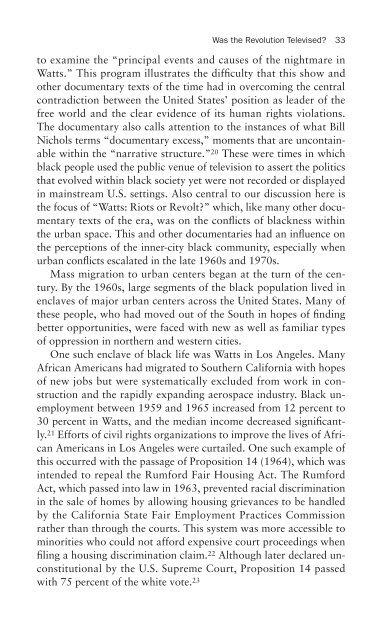Revolution Televised.pdf
Revolution Televised.pdf
Revolution Televised.pdf
You also want an ePaper? Increase the reach of your titles
YUMPU automatically turns print PDFs into web optimized ePapers that Google loves.
Was the <strong>Revolution</strong> <strong>Televised</strong>? 33<br />
to examine the “principal events and causes of the nightmare in<br />
Watts.” This program illustrates the difficulty that this show and<br />
other documentary texts of the time had in overcoming the central<br />
contradiction between the United States’ position as leader of the<br />
free world and the clear evidence of its human rights violations.<br />
The documentary also calls attention to the instances of what Bill<br />
Nichols terms “documentary excess,” moments that are uncontainable<br />
within the “narrative structure.” 20 These were times in which<br />
black people used the public venue of television to assert the politics<br />
that evolved within black society yet were not recorded or displayed<br />
in mainstream U.S. settings. Also central to our discussion here is<br />
the focus of “Watts: Riots or Revolt?” which, like many other documentary<br />
texts of the era, was on the conflicts of blackness within<br />
the urban space. This and other documentaries had an influence on<br />
the perceptions of the inner-city black community, especially when<br />
urban conflicts escalated in the late 1960s and 1970s.<br />
Mass migration to urban centers began at the turn of the century.<br />
By the 1960s, large segments of the black population lived in<br />
enclaves of major urban centers across the United States. Many of<br />
these people, who had moved out of the South in hopes of finding<br />
better opportunities, were faced with new as well as familiar types<br />
of oppression in northern and western cities.<br />
One such enclave of black life was Watts in Los Angeles. Many<br />
African Americans had migrated to Southern California with hopes<br />
of new jobs but were systematically excluded from work in construction<br />
and the rapidly expanding aerospace industry. Black unemployment<br />
between 1959 and 1965 increased from 12 percent to<br />
30 percent in Watts, and the median income decreased significantly.<br />
21 Efforts of civil rights organizations to improve the lives of African<br />
Americans in Los Angeles were curtailed. One such example of<br />
this occurred with the passage of Proposition 14 (1964), which was<br />
intended to repeal the Rumford Fair Housing Act. The Rumford<br />
Act, which passed into law in 1963, prevented racial discrimination<br />
in the sale of homes by allowing housing grievances to be handled<br />
by the California State Fair Employment Practices Commission<br />
rather than through the courts. This system was more accessible to<br />
minorities who could not afford expensive court proceedings when<br />
filing a housing discrimination claim. 22 Although later declared unconstitutional<br />
by the U.S. Supreme Court, Proposition 14 passed<br />
with 75 percent of the white vote. 23

















